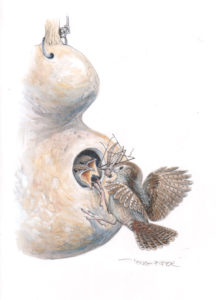As the Crow Flies Wrens: The Cave Birds
Story and illustration by Doug Pifer

As the sun broke through the rain clouds, a Carolina wren sat on the arm of a wooden yard chair next to our big forsythia bush, singing for all he was worth. His wet and molting feathers looked bedraggled but the sun was shining, his mate was perched nearby, and all was right in his world.
I love wrens. They go cheerily about their business hunting spiders in shadowy places, tails cocked upwards, wings quivering and eyes aglitter. Hereabouts we have the house wren, the Carolina wren and the winter wren. Two others, the marsh wren and the sedge wren, are less
often seen.
often seen.
House wrens are summer residents, arriving in April with their bubbling songs and distinctive chatter. I can tell if a house wren has taken over a birdhouse when it’s stuffed with small sticks and twigs. In spring, the unmated males frantically build “dummy” nests in strategic spots within their territories. Desperate to show off their skill at house building to prospective mates, they know that a female house wren will select the male whose nest suits her best. As she investigates each nest, the male lurks nearby, looking fretful and nervous. Should she choose to stay, his fluttering wings and shivering tail betray his joy — “she likes it!’
Wrens seem to prefer spiders as food, but also do them a service by providing a winter home. When I clean out my bird houses in the early spring, I notice the old wren nests are full of the white, silky cocoons that jumping spiders surround themselves with to hibernate. One wren nest might contain twenty or more hibernating jumping spiders, each snugly encased in a
silken hibernaculum.
silken hibernaculum.
Carolina wrens are year-round residents who prefer nesting near humans, building their mossy nests in unusual places. Over the years we’ve had Carolina wrens nesting in a bucket hanging in an old shed, a forgotten Christmas wreath, and in the container under a hanging plant. Pairs of Carolina wrens sing and call to each other all day long throughout the year, but around the nest site they’re so quiet they’re often undetected until the young are ready to fledge.
The seasonal counterpart of the house wren, the winter wren shows up here between October and April. Tiny and dark brown with a stubby tail, this is the “Jenny Wren” of Britain and Europe. In the USA, it summers in the North Woods of New England and Canada. Winter wrens haunt woodsy streams with mossy rocks and overhanging tree roots. There they skulk and chatter, making a lot of noise for a bird the size of my thumb. Last year toward the end of March I heard one singing from the little stream that runs through our woods. Softly repetitive, it reminded me of one of those antique clockwork birds. The winter wren is the quintessential wren, more mouse than bird. Its scientific name, Troglodytes, “cave dweller,” is also the name of the wren family, the Troglodytidae.
Truly “cave birds”, wrens boldly investigate every cleft in the rocks, tree cavity, brush pile, barn, shed, or bird house, whether occupied or not.







